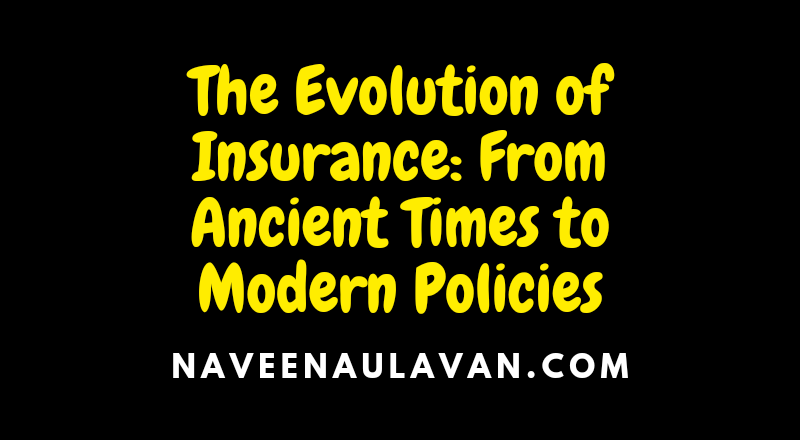Insurance is a concept that dates back centuries with its origins rooted in ancient civilizations. Over time insurance has evolved and transformed into the complex and diverse industry we know today. This article explores the fascinating journey of insurance from its inception in ancient times to the development of modern insurance policies.
Ancient Origins
Mesopotamia and Babylon
One of the earliest recorded instances of insurance-like practices can be traced back to ancient Mesopotamia (modern-day Iraq) and Babylon (in modern-day Iraq). Around 1750 BC merchants and traders engaged in maritime trade formed a system known as “bottomry.” Under this arrangement the borrower would repay the lender with an additional sum if the ship and cargo were lost at sea. This practice offered some protection against the uncertainty of maritime travel and was a rudimentary form of insurance.
Ancient China
In ancient China a form of insurance known as “guild coverage” emerged during the third millennium BC. Guilds were formed to provide social support to their members including compensation in case of accidents or disasters. Members contributed to a common fund that would be used to help those in need. These guilds can be seen as early examples of mutual insurance associations.
Emergence of Formal Insurance
Ancient Greece and Rome
Insurance practices also appeared in ancient Greece and Rome. Insuring against financial loss in maritime trade became common and individuals known as “naukleroi” acted as intermediaries collecting premiums and compensating for losses. The Romans further developed insurance by establishing burial clubs where members paid regular contributions to cover funeral expenses and provide financial support to the deceased’s family.
Early Islamic Insurance
In the medieval Islamic world a unique type of insurance called “aqila” or “mutual insurance” emerged. This practice involved pooling resources from a group of individuals to provide financial assistance to members facing unforeseen events. It was based on the principles of cooperation solidarity and mutual assistance aligning with Islamic ethical values.
The Renaissance and Insurance Formalization
Marine Insurance in Europe
The rise of global trade in the 14th and 15th centuries brought about the need for specialized insurance contracts. In Europe marine insurance gained prominence particularly in maritime hubs like Genoa and Venice. Merchants and shipowners created policies to safeguard against losses incurred during sea voyages due to accidents piracy or storms.
Era of Lloyd’s Coffee House
During the late 17th century Lloyd’s Coffee House in London emerged as a gathering place for merchants shipowners and insurers. This informal setting became a hub for information exchange and insuring marine risks. The individuals who frequented Lloyd’s Coffee House known as “underwriters would assess risks and agree to insure ships and their cargo in exchange for a premium. This marked the birth of Lloyd’s of London the world’s most renowned insurance market.
Industrial Revolution to the Modern Era
The Birth of Life and Health Insurance
The Industrial Revolution in the 18th and 19th centuries brought about significant social and economic changes. As the workforce expanded the need for insurance coverage also grew. Two key types of insurance emerged during this period: life insurance and health insurance.
Life insurance policies allowed individuals to protect their families and ensure financial stability in the event of their death. Health insurance initially known as “sickness insurance offered compensation for medical expenses and loss of income due to illness or injury.
Expansion of Insurance Companies
In the 19th century insurance companies began to form and evolve. These companies provided a centralized approach to insurance offering policies to cover various risks including fire theft accidents and more. Insurance companies accumulated substantial amounts of capital to cover potential claims making insurance more accessible to individuals and businesses.
The 20th Century and Beyond
Automobile and Liability Insurance
The proliferation of automobiles in the early 20th century led to the emergence of automobile insurance. Automobile policies were designed to protect vehicle owners from financial losses resulting from accidents theft or other damages. This type of insurance became a legal requirement in many countries to ensure protection for all road users.
Furthermore liability insurance gained prominence to shield individuals and businesses from the financial risks associated with legal claims and lawsuits. Liability insurance policies covered damages or injuries caused to others due to negligence or accidents.
Specialized Insurance Policies
As society became more complex insurance policies evolved to cover a wide range of risks. Insurance for property businesses travel natural disasters and even special events such as weddings and concerts became common. Additionally insurance products were tailored for different industries including healthcare construction aviation and more.
Technological Advancements and Insurance
The 21st century brought significant technological advancements that have transformed the insurance industry. The use of big data artificial intelligence (AI and machine learning has allowed insurers to improve risk assessment pricing and underwriting processes. Additionally digital platforms and mobile applications have made it easier for individuals to purchase insurance policies and file claims.
Conclusion
The evolution of insurance from ancient times to modern policies exemplifies the human desire to manage risk and protect against uncertainty. From simple guild associations to sophisticated insurance companies insurance has adapted and expanded to meet the changing needs of individuals and businesses. As societies continue to evolve the insurance industry will undoubtedly play a crucial role in safeguarding against future risks and uncertainties.
